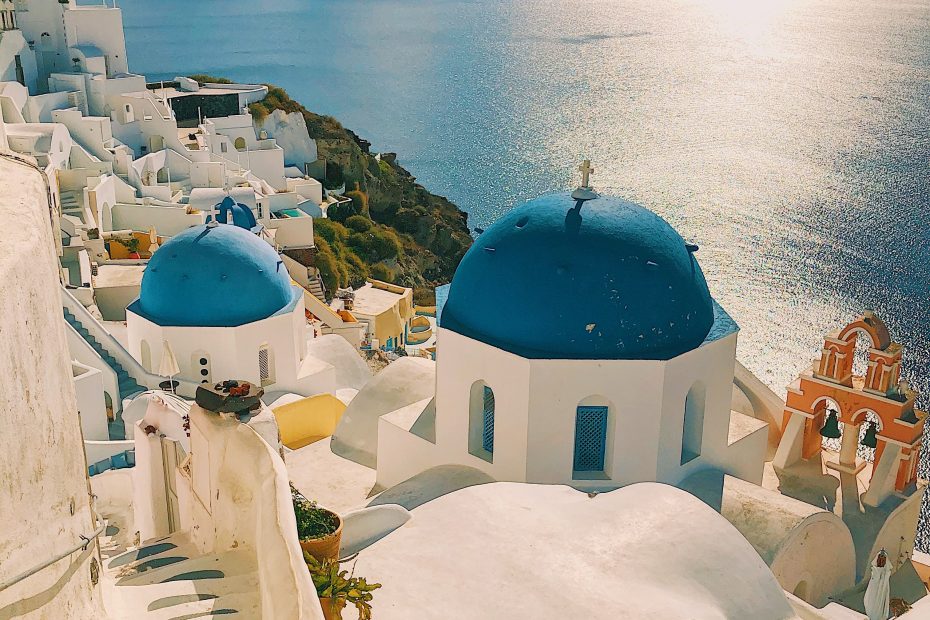Greece boasts over 13,000 kilometers of stunning coastline along the Mediterranean Sea, dotted with idyllic islands and beautiful beaches. Beyond the famous sun and sea, Greece also harbors a wealth of historic sites that provide a window into its role as the cradle of Western civilization. From the temples of Athens to the Minoan palace of Knossos, Greece seamlessly blends antiquity with natural beauty. Let’s explore some of the top destinations along Greece’s Mediterranean shores.
Table of Contents
The Ionian Islands
The Ionian Islands off Greece’s western coast offer a tantalizing taste of island life. Corfu, the most famous, enchants with its Venetian architecture and lush interior. The bay of Paleokastritsa boasts azure waters and secluded coves tucked beneath pine-clad cliffs.
Highlights and Attractions
Lefkada entices visitors with its pristine beaches, including Porto Katsiki with its sheer cliffs. Kefalonia, the largest Ionian island, stuns with underground caves and the famous Myrtos Beach. Lastly, picturesque Zakynthos allures with the iconic Shipwreck Beach and Blue Caves.
The Peloponnese
The Peloponnese peninsula in southern Greece combines history and natural beauty. Corinth, Mycenae, Olympia, and other ancient sites testify to the region’s prestigious past. idyllic towns like Nafplio with its Ottoman-era mansions topped with Venetian crenellations perch above the sea.
Nafplio
The first capital of modern Greece boasts narrow alleyways, neoclassical houses, and the hilltop Palamidi Fortress with panoramic views. Day trips lead to the UNESCO-listed Mycenae and the iconic theater of Epidaurus.
Monemvasia
This Byzantine-era town on a small island linked to the mainland by a causeway looks like it was hewn out of the rock. Inside the medieval walls lies a labyrinth of atmospheric lanes and aging stone structures.
The Cyclades
The Cyclades represent quintessential Greek island scenery with whitewashed villages spilling down hillsides to meet the azure Aegean Sea. Santorini ranks among the world’s most dramatic islands with its flooded caldera dotted with towns perched on the steep cliffs.
Santorini
Fira’s white-cube houses cling to the edge of the caldera, while Oia dazzles visitors with its sublime sunsets. Black and red beaches, like Perissa and Kamari, offset the blue and white tones.
Mykonos
This chic cosmopolitan island attracts visitors to its glamorous nightlife and paradisaical beaches. Whitewashed Cubist buildings, iconic windmills, and Little Venice’s waterfront cafes complete the allure.
Paros and Naxos
Paros charms with its traditional villages, lively port of Naousa, and palm-lined shores. Naxos, the Cyclades’ largest island, impresses with its Venetian mansions, olive groves, and pristine beaches.
Crete
Crete stands as Greece’s largest island, steeped in myth and home to the Minoan palace of Knossos. Chania’s Venetian quarter by the old harbor exudes romance with intricate lanes and remnants of Turkish architecture.
Chania
Sandy beaches like Elafonisi with its pink coral sand and Samaria Gorge await nearby. The atmospheric towns of Rethymno and Agios Nikolaos provide additional stops around the island.
Heraklion
Knossos Palace immerses visitors into Minoan civilization and mythology. Heraklion itself brims with lively markets selling Cretan delicacies and handicrafts. The world-class archeological museum safeguards Minoan artifacts and frescoes.
Rhodes
Rhodes charms visitors with its medieval Old Town surrounded by imposing fortress walls. Walking along the Street of the Knights transports you back to the era of the Crusader knights.
Lindos
This town south of Rhodes climbs a hilltop capped by an ancient Acropolis. Picturesque laneways lined with whitewashed houses lead down to the harbor and pristine beaches like St. Paul’s Bay.
Conclusion
From Corfu to Rhodes, Greece’s Mediterranean shores harbor some of Europe’s most beautiful scenery. Beyond the dazzling sun and sea, historic towns and ancient ruins bring the past to life. Greece offers a Mediterranean paradise where you can bask on the beach one day and visit mythical sites the next. As this journey has illuminated, Greece provides endless allure through its idyllic islands, dramatic landscapes, and echoes of antiquity.
FAQs
What are the main island groups along Greece’s Mediterranean coast?
The main Greek island groups in the Mediterranean are the Ionian Islands (Corfu, Lefkada, Kefalonia, Zakynthos), the Cyclades (Santorini, Mykonos, Paros, Naxos), Crete, and the Dodecanese Islands (Rhodes, Kos).
What are some top historical sites to see along the coast?
Top historical sites include the Acropolis and Delphi on the mainland. On the islands, must-see historical sites are the Palace of Knossos on Crete, Lindos Acropolis on Rhodes, and the archaeological sites of Mycenae and Epidaurus in the Peloponnese.
What are some quintessential Greek island activities?
Top activities include swimming and sunbathing on the beaches, boating to secluded coves and between islands, tasting local cuisine at waterfront tavernas, hiking trails like Samaria Gorge in Crete, and exploring the charming villages and towns.
What is the best way to travel between the islands?
Ferry boats provide connections between all the major islands and are the classic Greek island-hopping experience. Fast catamarans and hydrofoils also operate on some routes. Flights between the islands are available for quicker travel.
What is the best time of year to visit the Greek islands?
The optimal times are late April-June and September-October when the weather is sunny and pleasant without being too hot or crowded. July-August is peak season and very busy. Some hotels and sites close in the off-season months.
